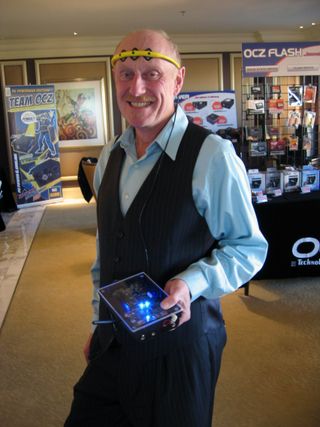CES '09: Morsels From Our Meetings
OCZ Talks About The Future
Our last stop before heading out of Vegas back toward sunny southern California was OCZ’s suite in the Bellagio, where it had set up small kiosks with existing and upcoming products.
One corner of the suite featured a Hypersonic PC with four of OCZ’s SSDs in a RAID 0 configuration saturating the limits of the PCIe interface linking the SATA controller to the southbridge logic. Up against the opposite wall was a mock-up of a chassis that the company plans to start selling under the OCZ brand.

Next to that was a 1,500VA battery backup unit with a pure sine wave output—the ideal waveform for a UPS to generate, as it most closely matches the AC signal you’d get from a wall. Apparently, customers running the company’s high-end power supplies have been encountering problems when plugging in to a less-expensive battery backup unit and then trying to run on battery backup. The resulting square wave wreaks havoc on the signal, shutting down the power supply. UPSes with pure sine wave output are already available, but they’re much more expensive. The model that’ll be coming from PC Power and Cooling should hit a much more enthusiast-friendly price point and still maximize the output of a single 15 A wall socket.
The opposite end of the room was all about Hypersonic’s notebooks—specifically an experimental new design with a slide-out LCD called Sonic Boom ATS, yielding two screens. I use three displays to work, so shifting over to a 12.1” notebook on the road makes it hard to acclimate. Obviously, expanding to a pair of screens would have serious ramifications on power consumption and battery life, but on a mobile workstation primarily drawing power from wall outlets, we think the concept is great.

Finally, we managed to catch OCZ’s vice president of product development (and the brains behind lostcircuits.com), Dr. Michael Schuette, toying with what he calls his latest invention: the Neural Impulse Actuator in wireless form. The project is interesting because it not only makes using OCZ’s NIA more convenient, but it also eliminates the ground loop noise that’d interfere with signals read from the previous model. The new iteration will be easier to calibrate and purportedly more precise in operation.
Stay on the Cutting Edge
Join the experts who read Tom's Hardware for the inside track on enthusiast PC tech news — and have for over 25 years. We'll send breaking news and in-depth reviews of CPUs, GPUs, AI, maker hardware and more straight to your inbox.
Current page: OCZ Talks About The Future
Prev Page Gigabyte's Affordable X58 And Ace's Maui-
neiroatopelcc So a new socket is planned for mainstream core i7 systems? If that's the case, why even invest in an x58 in the first place?Reply -
squatchman Reading hard!Reply
"Core i7 variant later this year with on-chip graphics, a different socket interface, and two channels of DDR3 memory support. "
It sounds like a crippled version of i7. Dual channel memory that takes DDR3 and some weak IGP? No thank you. -
enewmen At about that time, the socket LGA-1366 and LGA-1567 will be moving to server space while the LGA-1156 is for Desktop platforms. The good news is the Desktop platform when Sandy Bridge is released should be a lot faster for apps like games, recoding, etc. While the server platform will be better for databases, VMs, and other high-IO applications. I don't know yet if Sandy Bridge will be LGA-1156 or 1366, but I guess 1156.Reply
.001 cents worth. Lots of info on the web. -
cangelini squatchmanReading hard!"Core i7 variant later this year with on-chip graphics, a different socket interface, and two channels of DDR3 memory support. "It sounds like a crippled version of i7. Dual channel memory that takes DDR3 and some weak IGP? No thank you.Reply
It's all about getting that architecture into the mainstream though, right. For as well as it performs, i7 is still an expensive proposition. -
JonnyDough Too expensive. Which is why Phenom II seems to be picking up a bit of steam. Intel always seems to have issues with socket changes.Reply -
TwoDigital Reading through multiple web sites (including Intel's 2009 roadmap presentations) the socket 1366 is being targeted at 'enthusiast' users. They are also releasing a socket 1567 server connect (replacing the current Xeon socketj 771) and an entry-level socket 1160.Reply
Rumor has it the 1160 will retain the dual-channel memory controller system. The current i7s are based on LGA 1366 and the high-end motherboards I would expect to stay that way for the foreseeable future.
Most Popular


